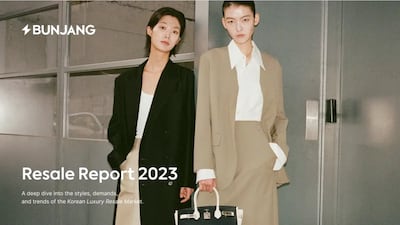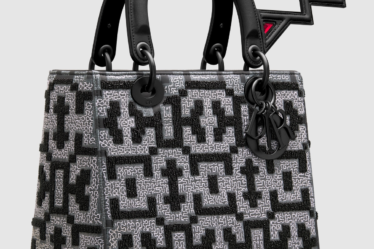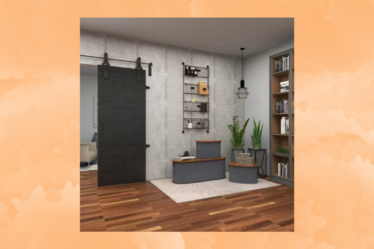
The rapid proliferation of e-commerce in South Korea — thanks in part to the high distribution rate of smartphones — is directly impacting shopping behaviour. South Koreans spent a total of more than $171.1 billion through e-commerce platforms in 2023, according to a report by South Korean newspaper Aju Business Daily.
Adjacent to this shift is a significant uptick in the consumption of luxury goods. South Korean consumers spend $325 per capita on luxury goods a year, according to Morgan Stanley — the highest spending globally, outpacing their counterparts in key markets such as the US and China.
As appetite for both frictionless e-commerce experiences and access to luxury goods continue to shape and define consumer behaviour in the country, the secondary peer-to-peer market continues to gain traction. Indeed, Korea’s resale market is expected to double its market share by 2025, as reported by online re-commerce business Bunjang.
A leading platform in Korea’s resale market, Bunjang saw the transaction volume of fashion goods sold exceed $833 million — ten times that of 2021. Responsible for more than 21 million transactions in 2023, Bunjang has leveraged its proprietary insights and surveyed 800 Korean consumers between the ages of 20 and 59 for its inaugural ‘Korean Luxury Resale Report’ to determine the key category insights, defining consumer trends and the scale of opportunity within the country’s secondary market.
“Our strategies have centred around those key consumer shifts we have been seeing — the growing importance of immediate accessibility, reasonable prices and, crucially, sustainability. We view this as a new culture that we need to not only be a part of, but also work proactively to build this culture and drive widespread adoption,” Bunjang CEO Jaewha Choi previously told BoF.
Below, BoF shares extracts from Bunjang’s report, distilling five distinct themes that will define the success of luxury resale in the region.
BoF: The growth of the global secondhand apparel market outpaced the firsthand sector 15-fold in 2023, with online resale experiencing accelerated growth at 23 percent year-over-year, according to research from ThredUp. In BoF Insights’ “Future of Resale” report, consumers surveyed from the US, UK, France and Germany citied “value,” “affordability” and “sustainability” as key motivators for shopping secondhand.
Bunjang Report: The Korean resale market saw accelerated growth in the last decade. Sales skyrocketed from 4 trillion Korean won (US$2.9 billion) in 2008 to 24 trillion won (US$17.4 billion) in 2021, with the resale market expected to reach US$31 billion by 2025, largely driven by online resales.
Indeed, shoppers gravitate toward buying secondhand goods online —more than 56 percent of Korean consumers who bought secondhand items in 2023 made their purchase online. South Korea is ranked first for having the highest penetration of online engagement in resale. While online resale has a reputation for usage by Gen-Z, online secondhand shopping in Korea transcends all generations, from people in their 20s through to those in their 50s. Online resale services receive more than 656,000 downloads per mont, and consumers spend an average of just under 79 hours per month on the top five re-commerce platforms.
Generations with purchasing power are expected to account for nearly half of the secondhand market as resale becomes a new cultural phenomenon. Consumers trade secondhand clothing the most through resale, followed by electronics and appliances, then sports goods.
BoF: Globally, the market for secondhand luxury goods continues to boom: approximately US$49.3 billion worth of secondhand luxury goods were sold worldwide in 2023, according to Bain & Co. Indeed, the resale market has doubled in size in just four years, with the consultancy expecting secondhand luxury sales to increase at around 15 percent annually over the next five years — double the rate of the primary market.
Some 71 percent of shoppers bought or sold used goods in the past year globally — with 63 percent of these shoppers marking a purchase at least once a month, according to new research by MPB and Retail Economics.
Bunjang Report: Despite global economic recession, the Korean luxury resale market demonstrates significant signs of growth. Indeed, the purchasing of pre-owned luxury goods is rising as inflation persists: 61.5 percent of Korean consumers shopped for secondhand luxury goods in 2023, while 20.2 percent of consumers filled nearly half of their luxury wardrobes with secondhand items. Ultimately, current economic challenges have led people to turn to luxury resale instead of the primary firsthand market: rising prices accounted for 76.9 percent of consumers purchasing luxury goods secondhand in 2023.
This motivation behind sales in secondhand luxury goods was followed by scarcity and sustainability, the latter of which is increasingly a priority for consumers today. In fact, due to a growing preference for sustainable consumption, consumers plan to spend more of their luxury budget on secondhand goods in 2024.
BoF: Quiet luxury, a term used to describe logo-free, understated but expensive garments from the likes of brands like Loro Piana, Brunello Cucinelli and The Row, has emerged as one of the fashion industry’s most significant trends and as a rejection of the logomania that typified the late 2010s.
While not a new concept, popular culture phenomena such as the HBO show “Succession” propelled this aesthetic into the mainstream. In 2023, Google searches for the term “quiet luxury’” grew by 614 percent, according to research from The Drum. At its peak in July 2023, terms like “old-money outfit” garnered 50,000 searches per month, while “old-money aesthetic” gathered more than 74,000.
Bunjang Report: Across the womenswear category, shopping behaviour shows an unchanging love for legacy brands, with the rise of the “old money” aesthetic. 2023 was the year of timeless classic bags, shoes and accessories; shoppers discovered forgotten legacy brands and quiet luxury brands. This mature and minimalistic trend elevated the essentials, such as logoless bags and plain white T-shirts, among fashion enthusiasts.
In August 2023, when the “old money” aesthetic emerged as a new cultural trend, searches on the platform increased 387 percent month-on-month. Meanwhile, tried-and-true luxury bags continue to garner popularity. Love for rare and exclusive high-end bags showed varying popularity according to each generation.
Searches for The Row were up more than 120 percent. Its Margaux bag has cemented itself as a signature of quiet luxury. Searches for Loro Piana were up 44 percent. While younger generations on the platform desire Prada for its affordable price point and sustainable options, such as its Re-Nylon bags, women above 45 identified the Louis Vuitton Alma bag as a key item, citing its heritage and craftsmanship. Classic styles from Chanel and Dior’s iconic Lady Dior bag proved to be the most coveted accessories brand among surveyed women.
BoF: The total value of counterfeit and pirated goods will hit $3 trillion this year, triple the amount in 2013, according to the Organisation for Economic Co-operation and Development. Sophisticated authentication measures are a critical component for many consumers to embrace the secondary market and place trust in peer-to-peer transactions.
Bunjang Report: While Gen-Z and Millennials remain the most prominent generations within the luxury resale market, 2023 was the year of welcoming a new, specific cohort: Gen-X men. Indeed, emerging luxury spenders who are male and aged 35 to 44 gravitated toward luxury resale — Balenciaga was the most searched fashion brand by this cohort, with Cartier and Bulgari the most searched accessory brands.
As resale logistics undergo technological improvements, this consumer cohort has embraced luxury resale, as authenticity of product is easier to guarantee. The number of men aged 35 to 44 using Bunjang’s authentication service “Bungae Care” increased by more than 27 percent, year-on-year. Meanwhile, luxury sneakers remain a popular category — Millennials and Gen-Z traded 16,000 pairs of luxury sneakers last year, with the Balenciaga 3XLs, the Gucci Rhytons and the Maison Margiela Replica sneakers the most sought-after styles on the platform.
BoF: Despite the region’s notoriously low birth-rate, the childrenswear market in Korea shows no signs of slowing. Korea’s childrenswear came to around $1.76 billion in 2023, up 33 percent from 2020, according to Euromonitor. Luxury brands in particular have seen the most noticeable growth.
Bunjang Report: Generation Alpha is anticipated to be the highest spender due to their status — better known in the region as “very important babies” (VIBs). Generation Alpha are pampered by Millennial parents — those spending $325 per capita on luxury goods a year — who provide early familiarisation with luxury brands. Baby Dior searches were up 33.82 percent on the platform, while Burberry Kids searches were up 6.46 percent.
Discover further insights in the report, including the Korean fashion brands gaining traction within the region’s resale market.
This is a sponsored feature paid for by Bunjang as part of a BoF partnership.



